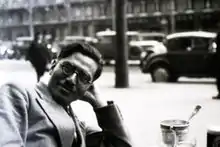Wajiro Kon
Wajiro Kon (今和次郎, Kon Wajirō, 10 July 1888 – 27 October 1973) was a Japanese architect, designer, and educator.[1] He is renowned as the father of "modernology", a branch of sociology which studied the changes in cityscape and people which emerged as a consequence of Tokyo becoming a modern metropolis in the early Showa Era.[2]

Wajiro Kon in Paris, 1930
Born in Hirosaki, Kon studied graphic design at Tokyo University of the Arts, and worked with artists and ethnographers. In the 1920s he studied rural Japan with the ethnographer Kunio Yanagita. After the 1923 Great Kantō earthquake he turned his attention to urban life, recording post-disaster conditions in Tokyo.[3]
References
- "Kon Wajirō". Nihon jinmei daijiten+Plus. Kōdansha. Retrieved 7 December 2012.
- "Kon Wajiro Retrospective". Panasonic. Retrieved 2012-12-04.
- Jilly Traganou and Kuroishi Izumi: "Design and Disaster: Kon Wajiro’s Modernologio", 2014
This article is issued from Wikipedia. The text is licensed under Creative Commons - Attribution - Sharealike. Additional terms may apply for the media files.
